August 2, 2018
|
|
|
There's a new sheriff in town! Grandson Liam, sporting his brand new #3015 T-shirt, is checking to see how our work measures up. After ensuring our quality is up to snuff he cleans the track, builds a temporary siding, runs freight cars through the yard to ensure usability and serves his Uncle John tea from his kitchen set. He proves himself the jack of all trades. |
Mike and LJ continue where they left off last week by adding a curve and siding north of TwentyMile bridge. Mike uses a level to ensure the 2% grade is maintained. |
The risers and cleats are assembled and ready to be transferred to the Portage Depot subdivision. |
|
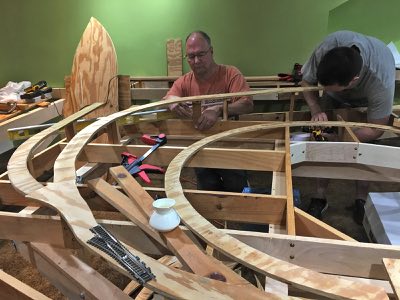 |
|
| Eastern view of the elevated roadbed from TwentyMile to the APU. |
LJ and Mike putting the risers in place for the run into the APU. At left is the siding to Portage Depot. In the foreground is the teapot Liam served tea to the work crew. |
Grandpa and grandson, each sporting their #3015 T-shirt, use freight cars to test the track to ensure proper gauge. |
|
|
|
| John runs track through the Anchorage Sand and Gravel industrial division. This track leads into the double crossover. |
John lays cork bed for the double crossover and then applies tape to hold it in place. |
The following day the tape is removed and the crossover put in place.
|
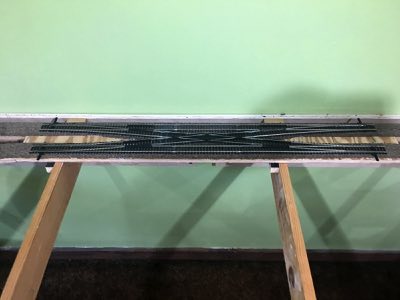 |
|
|
A side view of the double crossover. |
|
|
August 9, 2018
|
|
|
Although Tom and his motorcycle are still enjoying Sturgis, the rest of the crew bravely continues on without him. John is laying down track while LJ and Mike continue installing elevated road bed. |
John is laying three foot flexible nickel-silver code 100 track through the double crossover and into the reverse loop through the Tunnel subdivision. |
Looking west from the Tunnel subdivision through the double crossover and into Anchorage Sand and Gravel. |
|
|
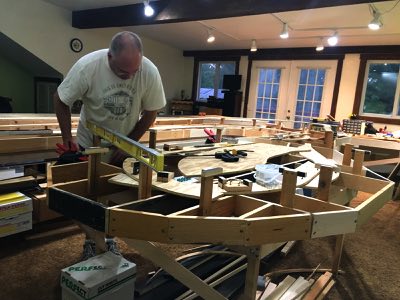 |
| The risers and road bed continue from the mainline near Portage depot (as shown by the red arrow) and now enter the APU. |
Mike and LJ are installing risers for the APU and Anchorage depot. Double track occurs for the mainline and Anchorage depot so the risers are wider to accommodate the double track road bed. |
New risers are installed along the southern curve. Mike ensures the new areas are "on the level". |
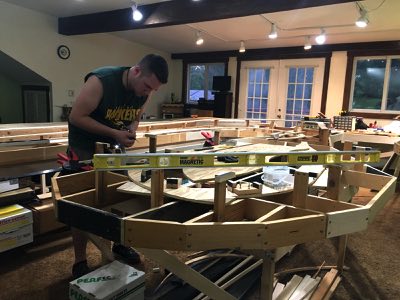 |
|
|
LJ prepares to install risers for the main line as well as the Alaska Marine Lines spur. The level is used to ensure the 6-inch height is maintained through the APU, Anchorage depot and Alaska Marine Lines. |
Double wide road bed along the southern curve between the Anchorage depot/APU and Alaska Marine Lines. |
Looking south at the risers/road bed of the southern curve between the Anchorage depot and Alaska Marine Lines. |
|
|
|
A more elevated view of the southern curve. As a reminder, the plywood road bed was repurposed from the table tops of the previous layout. The CFO would be so pleased.
|
LJ gets quite the workout installing risers, cleats and metal connectors for the road bed. He commented, "It is almost like going to the gym". |
An "end of the night work session" view of the Portage depot (foreground), APU (left) and TwentyMile subdivision (right). It is very exciting watching the progression of our work! |
 |
|
|
| The track around the reverse loop is almost complete. John got quite the workout tonight crawling under and around the joists. |
|
|
August 16, 2018
|
|
|
Tom has returned from his travels to Sturgis and admitted the only time he used his cell phone (other than calls and texts) was to check the website for progress on our layout. Obviously he is itching to get back to work on this monstrosity. |
Work sometimes comes to a halt to accommodate wagging tales. Max has mildly overcome his anxiety of strangers over the years and tonight really takes a shine to Tom. Eventually he will turn around 180 degrees for Tom to massage his haunches, a real rarity for Max. |
Nipping at the heels of the elevated track work by Mike and LJ, Tom lays down cork bed through the TwentyMile bridge region. Some day this work will be removed when we receive the custom built five and a half foot TwentyMile bridge from Mikel Levine in Cheyenne, Wyoming. |
|
|
|
Tom spreads Loctite 200 Projects Construction adhesive onto the plywood roadbed to hold the cork bed. The wavy lines suggest Tom may need to be fitted for new glasses! ;-) |
Tom finishes laying cork bed in the TwentyMile subdivision and heads into the Portage depot region. The blue tape is used to hold the cork bed in place. |
Tom stops short of the end of Portage depot to allow completion of the support system. He finishes for the night by laying cork bed into the near reaches of the APU. |
|
|
|
Although LJ is at a baseball game with his Sweet Babboo, Mike continues to make great progress working solo on the elevated track. Mike uses a small steel plate to join the sections of plywood road bed together. |
You are never short on hands when you have a nice set of clamps available! Mike mounts a riser to the joist in the APU subdivision. |
Mike uses repurposed plywood from the old layout to complete the mainline passing through the Alaska Marine Lines subdivision. All tonight's jigsaw cuts occur on the outside balcony to keep construction dust off the layout. |
|
|
 |
Mike lays down the plywood for the APU subdivision. All of use have talked about the APU since the beginning of construction so there is a certain excitement in seeing it take shape.
|
A view looking north. At left is the mainline around Alaska Marine Lines. At right is the mainlines and the siding for the Anchorage depot. In the middle is the APU. Excitement, excitement, excitement! |
Here is a crude video of running a locomotive running DC power from the north end of the layout along the Anchorage yard to the double crossover. Apologies for my finger getting in the video as well as an Exacto knife causing a derailment. |
August 23, 2018
|
|
|
Tom points out some of the flex track I laid was bowed at the joints. He pulls these sections of track up, solders them together and reinstalls. This effort will pay off in the long run as a derailment in the tunnel will translate to crawling under the table to place cars back on the track. At my age I hate crawling under a train table. |
As the track exits the area north of Alaska Marine Lines the height of the risers begin to drop. Mike measures these risers, applies a level across them, scribbles notes on a joist, makes the appropriate modifications and then repeats the entire process until the declination is perfect. Long story short, the Railmodeler Pro software does a lousy job of displaying incremental height changes so Mike and LJ do the necessary magic to make it happen. |
Tonight a comical ballet takes place as the entire team is working in the same general area. Bodies constantly jostle passed each other, but confirm the 24-inch walkways work well enough to let two people pass comfortably. In the above photo Tom is working on the switch at Portage while Mike is installing risers at the inside curve at the north end. |
|
|
|
LJ and Mike work meticulously to ensure the inside curve has the correct declination. Mike has a secret technique when using the level to show the proper drop.
As a side note in between our work sessions I removed the blue tape on the TwentyMile cork bed and installed track all the way to Portage depot. |
Although the Railmodeler Pro software shows a switch can be installed in the midst of a 24-inch radius curve our practical efforts prove otherwise. To remedy the situation Tom cut back part of the switch plus installs some of the track sticking out over the cork bed. Push pins hold the switch in place while Tom solders all the joints. |
LJ secures a riser to the ribbing for the inside curve. Just beyond his installation sits the plywood road bed which will sit atop his risers. At the end of each work session everyone comments on how excited they are with the progress and the big difference they see. Tonight they pointed out how they seem to say this every evening. However, it is so true! |
|
|
|
LJ was absent for our last session so it was great to have him back! With a drill in each hand he installs the risers for the double track section opposite TwentyMile bridge. Swapping a drill bit for a screw driver head takes too much time when you are the cordless Drill Master! |
There is a lot of excitement when installing a curved plywood road bed! Mike installs a riser while LJ deeply contemplates some future part of the project. |
Working curves in duet: Mike installs a riser for the inside curve while Tom makes modifications to the flex track on the outside curve. |
|
|
 |
LJ installs the final riser for the evening.
|
Tom uses our test car to visually and audibly ensure the switch and surrounding track work properly. |
It was commendable that Max stayed with us the entire evening. I believe his favorite part of Thursday nights is Terry's fabulous dinners. Tonight we had a hot dog/bratwurst bar, homemade mac and cheese, Mikesell's potato chips and chocolate peanut butter bars. Mmmm! |
August 30, 2018
|
|
|
LJ and Mike have secured the northern inside plywood road bed curve and descending double track to the risers. Now work can progress on the double track leading into Spenard (MP 105,08 to MP 110.61). |
Drill Master LJ attaches a cleat to a riser. Nine of these will be needed to bring the double track to the bridge. |
LJ and Mike attach a riser to the bridge section. This will be used as a test to ensure proper clearance of trains passing under the bridge. |
|
|
|
Colorado Rail Car's McKinley Explorer ultra dome passes under the bridge with less than an inch to spare. The original plans called for a four inch clearance, but this was increased to five inches to preclude imminent disaster. |
Standard and laser levels are used to ensure the proper rise through the Flint Hills Refinery subdivision. |
LJ gets a nice work out by laying on the floor and securing the risers to the plywood road bed. |
|
|
|
Mike and LJ work together to put risers into place. After the first screw is secured a level is used to ensure the cleat is level. If necessary the riser is rotated slightly. Finally, the second screw is put in place. |
A long board serves as a level as Mike and LJ secure the cleats. |
The white arrows show the cleats for the double track. |
|
|
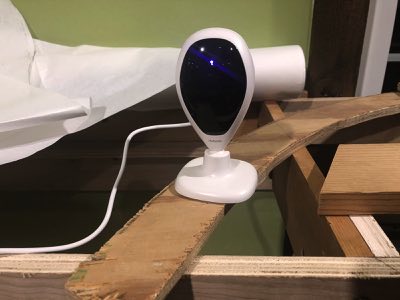 |
Mike holds the plywood road bed in place while LJ secures it to the cleats.
|
The plywood road bed for the descending double track and southern curve past Flint Hills Refinery is now in place! |
John purchased a remote camera for use inside the tunnel. This will be used to monitor the train in the event of derailment. |